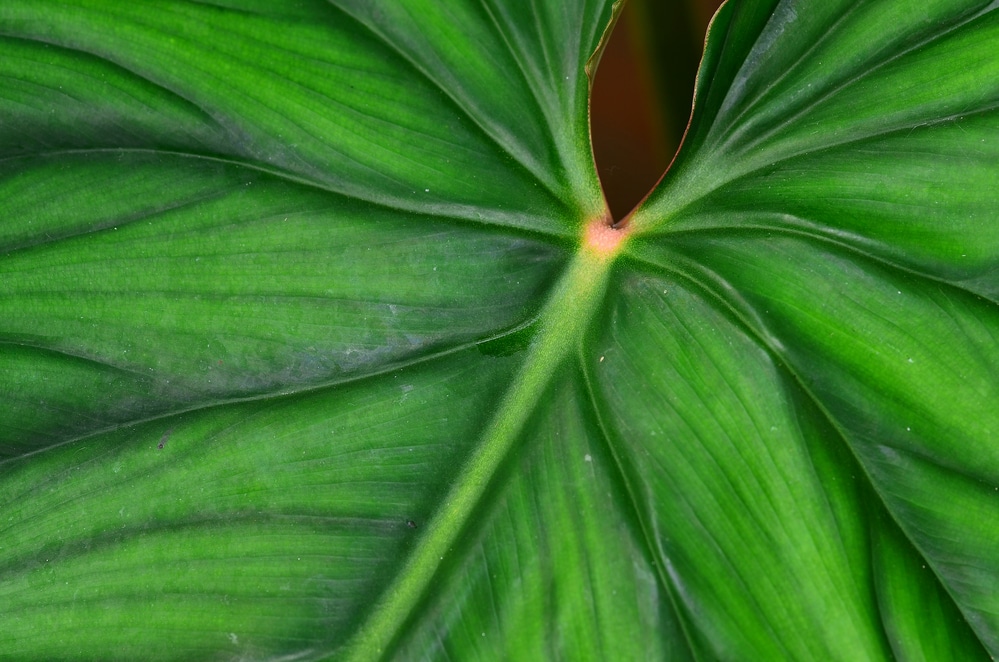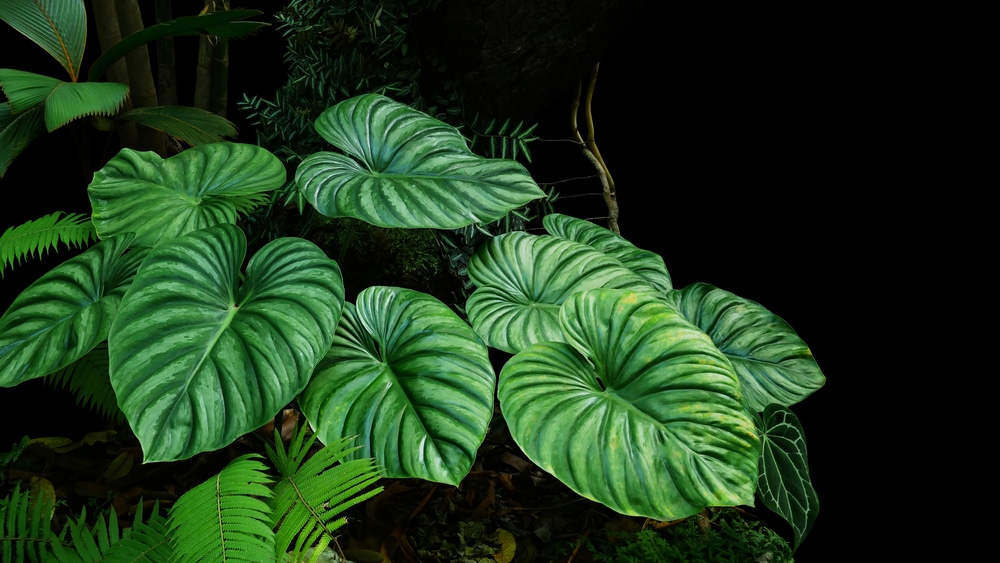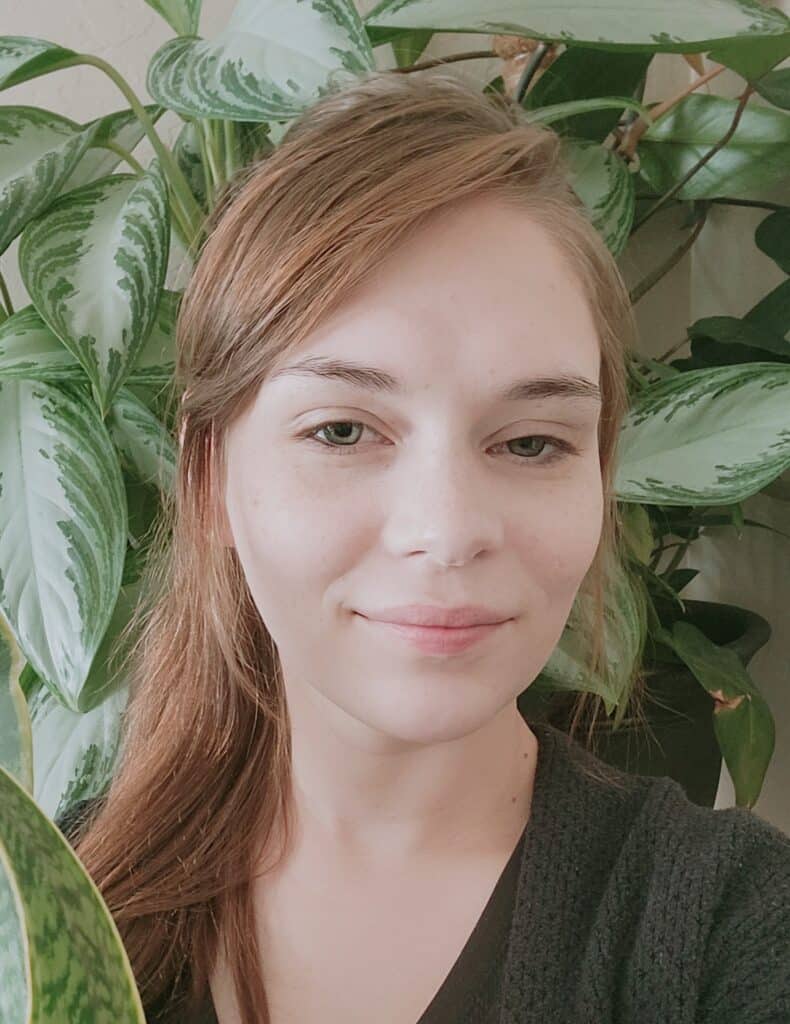Enormous heart-shaped leaves radiating several shades of green make this Philodendron stand out like no other. Philodendron plowmanii wants space to shine, and with the proper care, it will become a stunning statement plant. The leaves feature gradients of emerald green, lime green, or creamy yellow, and it’s easy to understand why this rare Philodendron is a top wishlist plant for all houseplant lovers.
About Philodendron Plowmanii
Philodendron plowmanii is a tropical plant from Peru and Ecuador. It is named after the botanist Timothy Charles Plowman. P. plowmanii is a new addition to described species, earning its name only in the last decade.
In its natural habitat, P. plowmanii can reach up to 30-feet tall. As a houseplant, though, it averages around 8-feet – still quite large! The leaves grow between 7-15 inches long. Between the tall growth and long, wide leaves, the look of this houseplant is impressive.
The massive leaves are the main attraction of this Philodendron. They’re heart-shaped, shiny, and exhibit a beautiful display of greens and yellows in an overlapping design. This coloring varies with light exposure. Usually, they are bicolor, but the hues merge from one color green to the next, which creates a more captivating display.
P. plowmanii leaves are semi-glossy and are gray-green on the underside. They are deeply quilted, adding a textural element to the overall look that is highly attractive and captivating. The leaf stems of P. plowmanii are unique in that they are ruffled instead of being smooth like most other Philodendrons.

Philodendron Plowmanii vs. Philodendron Mamei
Philodendron plowmanii is often confused with Philodendron mamei, but there are two easy ways to tell them apart. Philodendron mamei has silvery coloring on its leaves, while P. plomanii does not. The second key difference is in the leaf stem – P. plomanii has wavy-edged leaf stems (petioles) while P. mamei doesn’t.
Philodendron Plowmanii vs. Philodendron Pastazanum
These two Philodendrons are even more similar than others. They both have massive heart-shaped leaves with multiple shades of green coloring. However, P. pastazanum is lighter colored with white veining, while P. plowmanii is deeper green without any white.
Philodendron Plowmanii Care Guide
Philodendrons are one of the easiest houseplants to care for, and P.plowmanii is no different. It will be your faithful indoor plant companion for years if you provide the proper care.
Growth Habit
Philodendron plowmanii is a creeper, not a vining houseplant like most other Philodendrons. Its stems grow along the ground so as to create a sturdy base for the massive leaves. In the wild, it doesn’t climb trees but creeps along the ground to find light and nutrients.
This Philodendron tends to be a slow grower but will reach up to 8-feet tall at its peak. It doesn’t just grow long, though; it also gets quite wide, spreading to 2-3 feet.
Light
The best light is lots of indirect sunlight. It is best set back from a window a little bit, so the sun doesn’t directly touch the leaves. Or, a sheer curtain or blinds can be used to block the harsh sun rays. The full sun burns the foliage. Young leaves burn faster than mature ones, so be especially careful with new growth.
In its natural tropical habitat, P. plomanii is shaded by large trees and is accustomed to stretching out to reach the light. However, it does not like full shade. P. plowmanii will not thrive in full shade. It will still grow, but the growth will be even slower than normal, and the beautiful leaf coloring will be muted or look faded.
Many Philodendron species are fine in partial shade, but with this one, you don’t want to do that, or else the things that make it so spectacular will be lost.
Water
Tropical plants like P. plowmanii like moist soil that isn’t soggy and hate drying out completely. This may sound a little finicky, and it is, but it isn’t difficult to maintain at all. You just need to check the soil every time before watering to ensure it’s properly hydrated. And, don’t neglect to water.
To check the soil, simply stick your finger into the top two inches. If it’s dry, it’s time to water. If the soil is still moist, hold off watering for a few more days, then check again. It may take a little practice and patience to figure out your Philodendron’s schedule, but once you know it, watering becomes easy.
Even when you have P. plomanii on a watering schedule, it’s best to always check the soil before watering. Overwatering is a common issue with Philodendrons and leads to root rot and other serious issues.
Also, the watering schedule will likely vary throughout the seasons. Indoor climate conditions change with the water, and things like air conditioners and heating can change the plant’s water needs.
Philodendron plowmanii doesn’t need as much water in winter as it rests.
Temperature and Humidity
Philodendron plowmanii loves humidity – it is a tropical plant, after all. Average indoor humidity levels, between 30-50%, are okay but not ideal. When caring for tropical plants, it’s often necessary to supplement with additional humidity to keep them happy.
If you have a bunch of tropical houseplants, it’s a good idea to invest in a humidifier. This, of course, is a bit expensive, but worth it for a lot of plants. Another option is to create a DIY pebble tray humidifier. These aren’t as effective, but they do the trick pretty well.
To create a pebble tray humidifier, line a baking sheet with pebbles and place the plant on top of the rocks. Next, fill the tray with water. As the water evaporates, humidity goes into the air. You’ll need to refill the tray every week or every other week to keep it working.
The ideal temperature range is between 60-90F. Be careful that this Philodendron is not around drafts, air conditioners, wood stoves, or radiators, as these will dry out the foliage and soil and hurt the plant’s growth.
Soil and Pots
A well-draining, high-quality houseplant potting soil is the best for P. plowmanii. It is essential that the soil holds water to keep the plant happy but isn’t prone to waterlogging. This is easily achieved by adding a couple of handfuls of perlite and coco coir into the potting soil mix.
These two additions increase aeration so the soil can drain any excess water while keeping just the right amount of moisture.
Always use pots with drainage holes, so excess water is able to drain easily. When the water can’t drain, it gathers around the roots and causes them to rot. Root rot is a leading cause of death for Philodendrons.
The massive leaves may make P. plowmanii a bit top-heavy, so choose sturdy pots that can handle its growth and size. You don’t want ones that are too wide for the roots but just ones that are made of heavier material, like ceramic or terracotta pots.
Fertilizing
Once a month, during the growing season, add a well-balanced houseplant fertilizer. Never add fertilizer in the winter when the plant is resting.
Repotting
Philodendron plowmanii will be the happiest and healthiest if it is repotted every year. It doesn’t like being rootbound. And, due to its large size, it needs room to spread out. If you see roots are pushing out of the bottom of the pot or are about to, repot it.
Move P. plowmanii to a pot only 1-2 inches bigger than the one it is presently in. It is essential that you don’t put it in a much larger container and only use a slightly larger pot, the next size up from the one it’s in.
Plants that are put in pots too big for them easily get overwatered. All the extra space and extra soil mean more water ends up in the pot. The roots won’t be able to absorb enough of the water, which leaves a lot of leftover moisture. This then turns into a soggy, waterlogged situation and most likely root rot.
Repotting is also recommended every year because it refreshes the soil, providing better nutrient sources and aeration for the plant while it’s growing.
Pruning
P. plowmanii rarely needs pruning. Remove any dead or discolored leaves when you see them. And, if you want to create a bushier growth, you can cut it back, but it isn’t necessary.
Toxicity
All Philodendrons are toxic to people and pets. Keep P. plowmanii up and away from cats, dogs, and small children.

Philodendron Plowmanii Propagation
The easiest way to propagate Philodendrons is through stem cuttings. It is simple to do and creates new plants quite quickly. Only propagate from mature and healthy plants. The best time to propagate P. plowmanii is during the growing season.
Stem Cutting Propagation
- Sterilize a pair of scissors or small pruning shears.
- Select a healthy, green stem with at least one node. The node is at the stem joint, the spot directly below where the leaf connects to the stem.
- Pick a stem with several leaves and nodes – this is a fantastic way to tell that the stem is healthy.
- The stem cutting should be at least 4-inches long.
- Cut the stem just below the node.
- Remove the leaves below the node you want to grow. They will rot if they’re left on.
- Place the stem cutting in a jar of lukewarm water (too hot or too cold may shock the cutting).
- Make sure the node(s) are fully covered by the water.
- Place the jar in a warm location with lots of indirect sunlight.
- Change the water every 3-4 days to keep it fresh and prevent bacteria from building up.
- It takes anywhere from 3-6 weeks or the cutting to develop roots.
- Once the roots are 1-2 inches long, remove them from the water and plant them in a high-quality potting soil mix.
- Continue with the regular Philodendron plowmanii care.
Common Pests and Disease
This houseplant isn’t susceptible to many diseases or pests– just some of the common ones that all houseplants face.
Thrips, Spider Mites, Mealybugs, and Aphids
These tiny little pests either suck the juice out of leaves and stems or eat the leaves of houseplants. They are very difficult to see with the naked eye, but if you notice leaves developing little brown spots, yellowing, or not thriving, you most likely have a pest invasion.
The most effective treatment for all of these pests is a neem oil application. Spray the foliage and soil every 5-7 days until the bugs are gone. It’s important to make sure you get the leaf undersides and the top of the soil because that’s where the eggs and larvae may be hiding.
To make a neem oil solution, combine one teaspoon of dish soap with two teaspoons of neem oil in a one-quart spray bottle. Add enough water to fill it up and shake well.
Root Rot
Overwatered plants lead to soggy soil, which leads to root rot. The roots get so saturated with water that they can’t breathe, and they drown. This is the primary reason that well-draining soil and a container with drainage holes are imperative for a healthy plant. And, why adding a chunkier medium, like perlite or coco coir, to the soil helps so much – it creates air pockets.
Philodendron Plowmanii Common Questions
Here are a few of the most common question that we get about Philodendron Plowmanii care:
Why are the leaves of my Philodendron plowmanii turning yellow?
Yellow leaves usually mean the plant is being overwatered. Check the soil and reduce watering to see if this solves the problem. Remember to always check the soil before watering to avoid this issue. A second possibility is that the plant has pests that are damaging the leaves.
What is causing the leaves on my Philodendron plowmanii to turn brown?
Crispy brown leaf tips are caused by a lack of humidity. The air is too dry, which is causing the leaves to dry out. Increase the moisture with a humidifier or set up a pebble tray.
Brown spotted leaves usually are caused by a fungal or bacterial disease. In this instance, you’ll want to treat your plant with a fungicide.
Will my Philodendron plowmanii bloom?
Most likely, no. Indoor tropical plants rarely bloom – the conditions just aren’t right for it.
Why doesn’t my Philodendron plowmanii have heart-shaped leaves?
Young, newly developing leaves are rounded at first before turning into their well-known heart-shaped form. There also seems to be some variation in leaf growth, with some specimens having leaves with more pointed, triangular heart-shaped growth and others more rounded.
This spectacular Philodendron species is highly sought-after right now, which means it can be quite pricey. Or even hard to find. However, if you’re looking for a particularly stunning statement plant that is easy to care for, Philodendron plowmanii is the one. It may be worth making an effort to find it now, just to enjoy its beautiful foliage. Thankfully, once the challenge of finding one is done, it’s an easy houseplant to keep happy!

